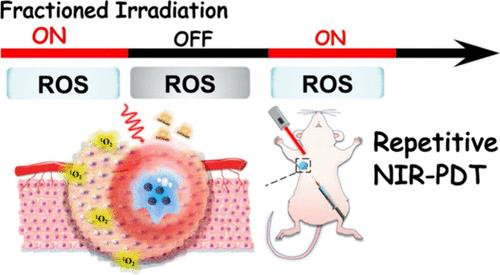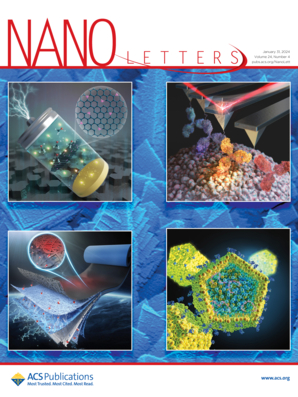Rechargeable Afterglow Superclusters for NIR-Excitable Repetitive Phototherapy
IF 9.6
1区 材料科学
Q1 CHEMISTRY, MULTIDISCIPLINARY
引用次数: 0
Abstract
Afterglow luminescence has attracted increasing attention due to its prolonged emission, reduced autofluorescence, and minimized photodamage. However, persistent luminescence typically requires high-energy excitation (e.g., ultraviolet and visible light), which has limited tissue penetration. Herein, we have developed a one-pot surface segregation strategy to construct NIR-excitable afterglow superclusters (UCZG-SCs) by modularly assembling spinel-phase afterglow nanoparticles (Zn1.1Ga1.8Ge0.1O4:Cr3+) and hexagonal-phase upconversion nanoparticles (NaYF4:Yb,Tm@NaLuF4:Y). Since the proposed methodology does not require crystal lattice similarity, it enables fabrication of various NIR-excitable persistent superclusters with great flexibility in size, composition, and luminescent profiles. As a proof of concept, an injectable persistent implant is established by embedding UCZG-SCs in the oleosol of poly(lactic-co-glycolic acid)/N-methylpyrrolidone, which serves as an inner-body lamp to excite photosensitizers for photodynamic therapy. With its excellent charging–recharging stability, a repetitive phototherapy under periodic 980 nm light illumination is accomplished, which significantly improves phototherapeutic efficiency and restrains tumor growth.

用于近红外可激发重复光疗的可充电余辉超簇
余辉发光因其发射时间长、自发荧光少、光损伤小等优点而受到越来越多的关注。然而,持续发光通常需要高能激发(如紫外线和可见光),而这对组织的穿透力有限。在此,我们开发了一种单锅表面分离策略,通过模块化组装尖晶石相余辉纳米粒子(Zn1.1Ga1.8Ge0.1O4:Cr3+)和六方相上转换纳米粒子(NaYF4:Yb,Tm@NaLuF4:Y)来构建近红外可激发余辉超簇(UCZG-SCs)。由于所提出的方法不需要晶格相似性,因此能够制造出各种可激发近红外的持久超簇,在尺寸、组成和发光曲线方面具有极大的灵活性。作为概念验证,通过将 UCZG-SCs 嵌入聚(乳酸-共-乙醇酸)/N-甲基吡咯烷酮的油溶胶中,建立了一种可注射的持久性植入物,该植入物可作为激发光敏剂的体内灯,用于光动力疗法。由于其充电-放电稳定性极佳,可在周期性 980 纳米光照射下实现重复光疗,从而显著提高光疗效率并抑制肿瘤生长。
本文章由计算机程序翻译,如有差异,请以英文原文为准。
求助全文
约1分钟内获得全文
求助全文
来源期刊

Nano Letters
工程技术-材料科学:综合
CiteScore
16.80
自引率
2.80%
发文量
1182
审稿时长
1.4 months
期刊介绍:
Nano Letters serves as a dynamic platform for promptly disseminating original results in fundamental, applied, and emerging research across all facets of nanoscience and nanotechnology. A pivotal criterion for inclusion within Nano Letters is the convergence of at least two different areas or disciplines, ensuring a rich interdisciplinary scope. The journal is dedicated to fostering exploration in diverse areas, including:
- Experimental and theoretical findings on physical, chemical, and biological phenomena at the nanoscale
- Synthesis, characterization, and processing of organic, inorganic, polymer, and hybrid nanomaterials through physical, chemical, and biological methodologies
- Modeling and simulation of synthetic, assembly, and interaction processes
- Realization of integrated nanostructures and nano-engineered devices exhibiting advanced performance
- Applications of nanoscale materials in living and environmental systems
Nano Letters is committed to advancing and showcasing groundbreaking research that intersects various domains, fostering innovation and collaboration in the ever-evolving field of nanoscience and nanotechnology.
 求助内容:
求助内容: 应助结果提醒方式:
应助结果提醒方式:


